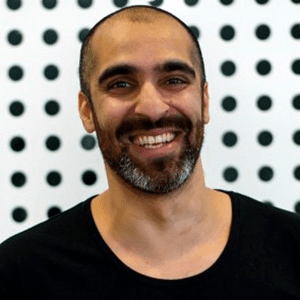

#74: Generative AI for SMEs
This thought-provoking episode explores the exciting possibilities that generative AI offers. By understanding this emerging technology and its implications, you can position your organisation to thrive in an increasingly AI-driven world.
Tim Martin. Founder of net101, sheds light on the historical journey of AI, from its origins in the post-World War II era to the present day. He touches on the concept of machines thinking like humans and the intermittent phases of progress and setbacks that have marked the development of AI over the years.
He points out that it’s essential to understand the nuances of AI Chatbots and shares tips on unlocking their full potential. ‘Generative AI is not meant to replicate human thinking or replace human intelligence but serve as a powerful tool to augment human capabilities and streamline work processes. It enables us to offload repetitive tasks, accelerate information retrieval, and empower us to focus on higher-level strategic thinking and creativity’ says Tim.
To gain insights into the implications of generative AI for your organisation this is a must listen to episode.
Stephanie: My guest today is Tim Martin, founder of Net101, a professional training organisation in generative AI tools, their advanced artificial intelligence and generative AI in-house training programs, equip teams with a broad array of tools and methodologies enabling them to enhance their workplace performance and productivity. Tim is also a prominent professional speaker, keynote presenter, and a commentator on business technology. Tim is convinced that generative AI will soon become an integral part of everyday operations across most industries. Tim Martin, welcome to TEC Live. Thanks, Steph. Good to have you here. Why are we all talking about AI right now? Is that because of chatGPT?
Tim: Yeah, look, mostly, I mean, AI’s been around for a while, all the way back to the 1950s as a, as a discipline and, and, and an application. So what’s happening now is this new wave of AI driven by, technological breakthrough in the last decade or so around deep neural networks, which allows us
Stephanie: To around, what was that?
Tim: Deep neural networks.
Stephanie: Right. Okay. Don’t, don’t brush over deep. No, sorry. It’s deep, deep neural networks.
Tim: Fascinating. Yeah. So it’s basically, um, mimicking or, drawing inspiration from how the brain works Yeah. In terms of, uh, signals traveling through from one neuron across synapsis to the next, and replicating that in a machine for what we call machine learning. So what this has given rise to a number of things, but what’s getting the headline attention at the moment is what we call generative AI, is using, uh, these deep neural networks to, um, train a machine on understanding patterns and text or images or videos, and then using a natural language command, being able to generate an output.
Stephanie: Yeah, right. Thank you for explaining that, because it’s the first time I’ve heard it explained that way, and with a way, way back clinical background. This is making real sense. Let me take you back to the 1950s for a special treat. What was the AI in the fifties?
Tim: Well, it kind of came off the back, the second World War we actually park and so forth. Yes. Building the, um, the computers there, um, trying to, to crack the, the Gemma ciphers and so forth. And after the war, they had a lot of infrastructure there and a lot of very smart people. Alan Turing, uh, being was that that essentially posited that possibly machines could think, um, the idea that they could build a machine powerful enough to replicate the human mind. Um, it didn’t actually pan out that way, that there just wasn’t enough computing power at their disposal. Um, jumped forward a few years to the mid 1950s, a group of, um, American academics, got together at Darth, the College for conference, and they thought they could finally crack this nut. And that’s where the term artificial intelligence comes from. Um, John McCarthy coined the term. So we, we’ve kind of, it’s been a bit of a rollercoaster journey, what we call AI winters, where we think we are going to create that could mimic the human brain and do a lot of what we can do. Yes. And then it doesn’t work and falls into a dip, and then we think it can work again, and then not we’re in the summer at the moment, uh, sort of game on again.
Stephanie: Right. Interesting. So that’s why science fiction writers could talk about robots that could think Yeah, because the idea was there already.
Tim: That’s, that’s right. Yeah. And the idea actually goes back, um, a long way, you know, mythology, for example, humans aspiring to, to think or be as powerful as the gods, for example, uh, even Frankenstein, uh, Victorian example of, of can we create something that can think like us? Oh,
Stephanie: That’s really interesting. Mm-hmm. <affirmative>. So if, um, technology now can mirror the neural pathways of the brain, there’s only a, there’s only a portion of the brain that’s being, um, replicated because science doesn’t even understand the whole capability of the brain
Tim: Completely. So, so let’s be clear that the inspiration for deep neural work networks comes from the brain, but we know we close being able to replicate the complexity and, and as you rightly pointed out, a lot of, uh, people, most people, no, no person understands how the brain completely works. You know, the, the basic mechanics of it, but it’s a mystery in terms of, you know, how we hold memories and, and do what we do. Um, so need to make a distinction up front in terms of creating machine that is capable of learning machine learning, but not thinking.
Stephanie: Yes.
Tim: Right. Yeah. We know we’re close to that or
Stephanie: Feeling
Tim: Well, or feeling, I mean, it, it’s interesting philosophically to try and delve into what thinking and feeling is. It really is. At the end of the day. It’s a, it’s a good thing around a campfire with a glass of wine, but in terms of what we, I
Stephanie: Look forward to it too. Oh, yeah.
Tim: I, I, I’ll call you <laugh>. Um, but yeah, in terms of what we’ve got today, the question around whether it can think or not is, is irrelevant. Right. It’s a tool, it’s a business
Stephanie: Tool. So the, the learning of neural networks is adaptive. So, so if I, if I do this, if I take this action, this is the outcome, therefore I’ll take that action.
Tim: Yeah. That’s, that’s more of a, what we call inference
Stephanie: Uhhuh.
Tim: Deep neural networks are interesting in that you can train it on, on data to recognise patterns. Got it. And then be able to extrapolate in your original of those patterns. Got it. Yeah. So it’s, the interesting thing about it is that it’s largely unexplainable because if you look at a deep neural network, you can actually see signals being pushed through it, but they’re just a set of numbers. You can’t actually ask the machine how it came up with its prediction or its estimate or its outcome, it’s unexplainable.
Stephanie: Right. Wow. Well, that’s, that’s really interesting. So given that, and you said that we’re in a, now mm-hmm. Of, of AI development. Yeah. And so this brings us to generative AI. So tell me how this is distinctive from just the general term of AI.
Tim: So from a business perspective, generative AI or set of tools off the shelf ready to go now? Yes. Which is interesting. It’s not sort of pie in the sky or the big end of town. Yeah. Or a lot of resources that are required. This is stuff business, uh, micro businesses right up to multinationals can start using literally this afternoon. Uh, interesting. A lot of them are not, because it’s not that that people playing catch up. It’s so new. I mean, it’s really just happened in the last several months.
Stephanie: That’s right. It’s post-Christmas.
Tim: Yeah. No, exactly right. Yeah. So the, the business community’s like, okay, I’ve heard a little bit about it. Um, maybe you’ll experiment a little bit, but how does this actually apply to me? And it’s, and it’s a whole, it would be like me, um, going back, I dunno, 30 years and saying, Steph, I’ve got this cool thing, it’s called Excel. Like, what is this thing? Excel? Oh, let me tell you.
Stephanie: Still feel like that <laugh>. Yeah. Well, secretly, no, it’s my daughter actually coming home from high school saying, do you know what we did, Yahoo. Mm. Let me tell you about it. And you can actually go onto the internet computer. That’s right. And you can search things through Yahoo. That, that’s kind of what it’s like, is
Tim: Yeah, it is. Um, this, the implications of this, uh, technology are probably a little more powerful than some that we’ve had in the past. Yeah. But, you know, you don’t talk about having a, an Excel strategy at work. And so forth. Basically, it’s a given that all businesses have one, it’s, it’s a, it’s a force multiplier. You can do it on paper if you want. Yes. But why would you do that? Yeah. So this is what the business community getting their heads around is what will this actually look like in terms of our workflow Yes. Job descriptions for our people. Yes. Um, and you know, fast forward a few years, you won’t be talking about it as a thing. It’ll just be so embedded in invisible. Right. Just be part of your everyday life.
Stephanie: Right. Like email.
Tim: Like email. Exactly. Right.
Stephanie: So Colin Fraser was here, um, on TEC Live a little while ago, and he was talking about how this democratises technology, generative AI, because you or I have the same access to this as a huge business. Mm. And for the same kind of cost.
Tim: Yeah. $30 a month, generally
Stephanie: And that’s a huge difference now, isn’t it, compared with options in other sorts of technologies in the past.
Tim: Yeah. Well, I mean, the bigger picture, ai, there’s all sorts of technologies around that, or applications rather, that are more complicated, more expensive Yeah. And so forth. But generative AI is, is really, as you say, is democratised. It’s accessible to everybody. Um, it’s not a function of your intelligence or how big your pockets are. Yeah. It’s a tool.
Stephanie: All the complexity of your business,
Tim: All the complexity, in fact, um, no, exactly right. All the complexity. It’s, it’s, it’s ready to go right now.
Stephanie: So it’s ready to go off the shelf. Let’s talk about specific examples and some specific applications for the kinds of businesses that, that you and I know. That kind of mid-size business, but let’s talk about chatGPT. What else are we discussing here?
Tim: Mm-hmm. Okay. So generative AI is being able to take an input and generate an output. Right? Right. The, the most common input is text. So using natural language as a command. So rather than having to know a programming language or a set of formulas for Excel Yeah. You just can speak or talk what you would like out the other side.
Stephanie: Yes. That’s a huge breakthrough, isn’t it?
Tim: Yeah, it is. But there’s a whole art and how to talk to the machine. I, I call it horse whispering. Ah. Um, and it’s actually, you know, a, a new title that’s, that’s appeared, uh, on the scene called Prompt Engineering. So, um, prompt engineer knows how to talk to the machine, how to, how to whisper to the horse to get the output. So that’s a skillset that, that, um, everybody or organisations will have to have at least one person that knows how to generate the output based on what the business objective for the output is.
Stephanie: Okay. That’s good.
Tim: Yeah. And it’s, it’s a whole art around it because you use something like chatGPT, you can put in a fairly basic prompt. Right. But what it really wants is this is how the machines were trained, and the more context you can give the, the, the command or the prompt. The better the output. So training people to use, nuanced prompts. Is, is really something. What
Stephanie: Would be an example of a nuanced prompt versus just something pretty generic?
Tim: Okay. So lot, lots of reference points. So for example, you might say, um, I would like this written in the style of a New York Times opinion piece. Ah, uh, three to 400 words long. I would like the last sentence to finish with an inspirational quote. Um, uh, something to do with, with war or Latin or something along those lines, but the more information you can give the machine the better the output
Stephanie: You’re refining the search.
Tim: Yeah. And it, and, and that’s an interesting point, that it’s, it’s, it’s unlearning, uh, habits with search, because search,
Stephanie: So it’s not go, it’s not going into Google to look up at restaurant in Santorini.
Tim: Yes. No, we’ll see No for the moment. Yeah. So there’s no knowledge there. That’s the, the thing that people need to get their head around is that there’s no knowledge bank, Google and the search engines have a knowledge bank. It’s a data center of crawled websites, and they return results. Right. Based on what they find. There’s no knowledge in, in a large language model like chatCPT, it generates words on the fly.
Stephanie: Right. Based on what, though?
Tim: Based on, um, well, knowing somebody by the company they keep, so the machine learning, the deep neural networks have been able to pick up semantic relationships between words. So it’s been trained on a large corpus of knowledge. Words text mostly from the internet, but not entirely. So books, articles, research papers, nothing they get their hands on. And these deep neural networks understand the patterns or the semantic relationships in words. So when you give a machine a prompt. You are giving it context, and it now can pull words that it thinks make sense in context. And these machines actually create one word after the next as they go, they actually sort of like laying little bits of track down in front of the misses, the train moves along. So there’s no knowledge.
Stephanie: It’s amazing.
Tim: It is amazing.
Stephanie: So I’m thinking, going back to neurophysiology, if you, um, have a repetitive pathway in the brain, a nursery rhyme. That, that gets laid down and becomes very familiar and easily retrieved, even if you have a memory issue, or maybe even if you’ve had a head injury or a stroke, you might still be able to retrieve that pattern because it’s laid down, you know, a long time ago and over and over and overused. Is that a similar thing?
Tim: That is exactly how it works. So, right. The machine learning process is basically carving that neural pathway out. So basketball, for example, you know, learning how to shoot a hoot, their initial attempts are fairly ordinary. Right. But they take feedback in terms of what’s working and not working. And their feedback helps them adjust the parameters. The parameters would be the position, their feet, position their arms and so forth, and the force they’re using. That’s what a deep neural network does, is that it gets, um, takes a guess, tries to do something, it gets feedback as to how well it’s done. And the feedback either reinforces or changes in some way the parameters. And you go through that loop enough and you’ve got a learnt model. Yes. The learnt model, you can actually look at it, you can see the pathways, you can see the inputs and the weights of those inputs and so forth. That’s exactly as you’ve described.
Stephanie: Yeah. Interesting. So chatGPT, that’s the, the one for now. And is that interesting? If we get back together in six months, this might sound really dated.
Tim: Uh, it will. Yeah. Please don’t watch this six months from now,
Stephanie: <laugh>. Um, no, it no, please do. Yeah. <laugh>
Tim: It will and it won’t because chatGPT has got all the limelight because it was the first out of the gate. The technology’s actually been around a while. Um, I Google actually the forerunners and it themselves with their, um, their various labs and so forth, but they, they sat on it for reasons that they didn’t wanna release it. It was fundamentally flawed. It was full of bias. Uh, yeah. And accuracies, or we call it hallucinations and so forth, just makes things up open AI with chatGPT didn’t worry about those concerns. They just released it and they got all the limelight. But really it’s the bigger picture at play that the large models will come from different quarters. There’ll be specialist ones for certain industries, but we’ll, we’ll each have our own large language models in house down the track. And it’ll probably be, I don’t know, a couple of years, three, four years away,
Stephanie: But for our own, so TEC will have its own large language model.
Tim: It will. And what that will do is it’ll be trained on your data. Um, so you’ll be able to use a natural language query to Yes. Try and get information out. That could be financial, it could be the topics that Chairs are doing. Um, it could be insights around members if we can feed that data in. Yeah. But you’ll have your own, um, you, there might be reason to use a large language model, an external one like ChatGPT or Bard, but we’ll all have our own.
Stephanie: Wow. So that makes a lot of sense. Also for use cases, um, medicine.
Tim: Oh yeah.
Stephanie: Judiciary. Yeah. Um, something that needs to manage bias. That’s a whole other topic. Mm-hmm. <affirmative>, but yeah. Right. Okay. So that education,
Tim: Oh yeah. That’s the, the Victorian model of a teacher standing in front of a classroom of 30 kids. That’s, that’s due for a big shakeup. You know, I’m not saying that kids won’t go to school, there’s a reason for that. Um, but how, how people learn how we retrieve information, um, is, is fundamentally gonna transform.
Stephanie: And how we, how we synthesize information and then present it, of course, that’s going to change. And you can’t fight it.
Tim: No. The good news is that people are thinking, wait a minute, we’re all gonna be out of a job. Yeah. Uh, is that there needs to be a human in the loop. The idea that you push a button and just get degenerative output on that’s your work done for the day is absurd. So, um, generative AI is really good for doing the heavy lifting. Uh, we think of something like chatGPT t to start you off to take a document to summarize it, to give you the main points, to give you inspiration and so forth. But it’s the human side that needs to finish the work together to the level we want it. So it’s, it’s basically, it’s, it’s augmenting our specialness. It’s not gonna replace us.
Stephanie: And do you know what I like about it? When you think about the future of work, people saying, I need to be wherever, cuz I get so much work done. Mm. Well, if that work can be done actually kicked off in a matter of seconds. Then that person could be well synthesizing it or being more strategic about what could I do with this? How could this be useful in my case, how could 1100 small businesses find this useful rather than taking forever to think about it.
Tim: That’s it. You know, and, and my personal experience has been exactly that. You know, it, it’s been, uh, it’s hard breaking, the search habit mm-hmm. <affirmative> for 20 years, I’ve just Googled things. Yeah. And now it’s like, oh no, wait a minute. Maybe I should get information from there. And once I’ve got that information, maybe I should mold it into shape. Because you can go through an iteration process that you can’t do a search, and then you start thinking, well, what else could I do with it? Could I take, um, some content that I’ve already got and could I reframe it? Could I make it for academic level and reframe it for the reading level of a 12 year old? Yes. Or could I repurpose it? Could I take it and turn it into an AI video using an avatar? Yeah. And the answer is yes. Yes. Yes. Isn’t it exciting into all of it?
Stephanie: So you’ve got me at search, you had me thinking about being in a room with you a long time ago in Melbourne and you saying everyone’s search, who’s the smartest man in the world? And I think Tim Martin came up because you played the system.
Tim: Stop it. <laugh>.
Stephanie: So how, how do I apply it? So let me give you some examples. I’m a first time CEO and I know I need to know this stuff. Um, yeah. How does a so let me give you, throw some examples at you. How does a first time CEO embrace generated AI?
Tim: Mm. So the tools there ready to go. I mean, Bard’s free, um, open chatGPT is free, or they pay if you want the, um, GPT Four money aside, the starting point is to go in and start playing with what I call constructive tinkering. Right. But from my experience, a lot of people come up against it and they’ll, they’ll throw a very simple prompt on it. Like, wow, you know, I wonder if I could do a poem about a three-legged dog and say, of course it can do that, but go to the next level and, and, and, and use some more sophisticated prompts. Yeah. And the trick here is try and approach it as if you’re talking to a very, very intelligent person that needs very clear instructions. Mm. And if, if you say, for example, I would like, um, you to take this document, I’m gonna paste in a bit of stuff.
We’ve gotta be careful we don’t paste in sensitive data. That’s a side issue. Yeah. But I always like you to take this document and I would like you to spot any logical or, or, or positional inconsistencies in it. Yeah. And, um, and take the position of one of those inconsistencies and give me what the counter argument would be. Now that’s literally a prompt, the way I just described that is what you would type in, I mean, down the track, just talk it in. Um, and you think, oh, that possibly couldn’t work. It works. And that’s the sort of the level, it’s, you’ve gotta start talking to the machine, not typing keywords in or very simple commands.
Stephanie: Yes.
Tim: And this is where you get the most out of it. So there’s, there’s, when I talked about prompt engineering before, that’s the art of knowing how to talk. Right. And interestingly, the people that do the best with these prompts are the ones that have great life experience because they’ve got more reference points. Yeah. If you wanna make reference to a genre or an artist Yes. Or a publicatiion, or an argumentative style, those are reference points. And of course you have to live life a little bit to be able to throw those in. So the people and the, you know, I mean, I always thought it was a weird thing that social media responsibilities were given to young people. That was a Yeah. Old horses trick because you know, you have to be wise in saying things that resonate with the target audience. Yeah. Very similar thing here. The, the, the more experience you’ve got, the wiser and broader your knowledge is the greater your, your ability to coax out of the machine.
Stephanie: And inherently the more nuanced you are in your thinking and your language,
Tim: That’s exactly it. You know?
Stephanie: Yeah. Okay. So the difference between, um, learning and thinking, the difference between search and generative AI and here the importance of prompt engineer. So, so I’ve heard you saying then for a first time CEO play with it, but explore it with some, um, intentionality. Rather than looking at where do I go to a restaurant in Santorini, cuz that’s actually search.
Tim: That’s right.
Stephanie: So the other thing then is what about in a business? Let’s expand to a mid-sized business. And the CEO, I imagine would be, I’ve got my head around it, I’ve listened to this podcast, I’ve got my head around it, you go and do it. Smart person in the corner. What do you think about that?
Tim: I think it needs to be collective. I think because we’re all learning this together, and that’s because it’s just so new that we may as well do it together as a group. Um, and I think the importance of, of, as a group, understanding the implications of it, because I mean, I could go into an organisation and say, well, you could use it this way and that way and that way. But of course every organisation has its own particular workflows and, and yes. Nuance around what they do. It’s the ability to join the dots to say, okay, we could do a summary of that and then we could take that and we could flip it over there and then we could do a generative, I can’t map that out, but as long as you’ve got the dots, then the joining can take place. Mm-hmm. So it’s really, I I think the first step is, is a is a working group mm-hmm. That you’ve gotta get some, some pilot projects up and running. Yes. You need to explore it collectively, as I said, because we’re all on the, that that same level level together. And then to sort of apply what the business is setting out to do in its same particular way to what you’ve just learnt. And that’s the, that’s the gap. That’s sort of, I mean, somebody like myself wouldn’t be able to necessarily fill because I, I don’t understand the business well enough.
Stephanie: So it’s understanding, one way you could look at it is what are the systems in the business that’s rights speaking from personal experience right now, and what systems are lacking. And so, so you’re applying a solution to actually a well-defined problem rather than saying, which I, I I think businesses are now I’m having a go at chatGPT I could use it here, but actually, and what I’m hearing you say is it’s, it’s more of a strategic view of this. And it’s very interesting you saying that every business as soon as three years will have their own internal
Tim: Oh yeah.
Stephanie: Version.
Tim: Yeah. Yeah. I look, you know, the podcasts like this, talking about this particular wave of AI. I mean, there’s another big wave of AI coming. Well,
Stephanie: That was going to be my next question. So why don’t you finish this point and then we’re heading there. Yeah.
Tim: But this particular wave, it’ll, it’ll probably just bottom out. Um, I would imagine and it’ll just be business as usual. Yeah. It’ll fundamentally change the way we do work. We’ve discussed that already. Some, some, yeah. I, up until recently I was thinking, you know, are people gonna be replaced? And I was saying no, but I’m actually thinking there are some job roles that, that will be replaced without a doubt.
Stephanie: Repetitive.
Tim: Yeah. The, so that tends to be the, the white collar niche, uh, professions where you’ve got, um, a complex process that takes a while to learn, which is why they’re niche and, and paid well generally, but they’re repetitive. So a machine can be taught on that process. Um, and you do a far, uh, I say better job, a similar level outcome, but at a fraction of the price and, you know, orders of magnitude faster. So I can’t imagine why we have that person sitting there pulling down a salary when we’ve got this here. Someone still has to manage the process, but in terms of, you know, legal conveyancing, for example, it could be a paralegal level that’s managing that process rather than the conveyancer or
Stephanie: A psychologist writing a report based on an assessment.
Tim: Yes. Um, yeah, exactly Right. So the psychologist is still the human in the loop and that’s important. Yeah. The actual
Stephanie: Doing the assessment. That’s
Tim: Exactly right.
Stephanie: But the report writing,
Tim: Yeah. I mean, you should see some of the reports that, I mean, I can throw a report in and, and get the large language model to rip it to bits. Uh, I can, I can analyze sentiment. Um, I can track all sorts of things just by using a, not a voice command, but a natural language prompt. So all of a sudden, um, there’s certain things that, that would’ve been done by certain people that are no longer necessary. Mm-hmm. Now hopefully, you know, they’re, they’re not on the unemployment queue or we’ll get them to do something else, but that job role as such might not exist.
Stephanie: Yeah. So what’s coming down the track then?
Tim: That’s the many dollar question.
Stephanie: Yeah. <laugh>.
Tim: So what we are looking at is if, if AI is in a summer, you know, we’ve gone through winter in the 1980s and, and, uh, we’re pretty much up to the mid two thousands and we’re, we’re heading into, um, golden times, will it flatten out? Will it go into another AI winter or would the next step be something along the lines of, uh, what we call strong, uh, AI as opposed to narrow for generative AI. Which would look like an artificial general intelligence along the lines of you and I, Steph. Mm. So that it’s, it’s cross the main capability, um, reasoning, um, the ability to learn very quickly, um, everything that you and I can do, but a lot faster. Right. That would up end society as we know it. Now, there’s a big question mark around that. I love Stephen Pinker’s Quip, um, that, you know, artificial general intelligence, uh, has been just around the corner for the last 15, 25 years. Everyone says it’s about to come and it never does.
Stephanie: Yeah, yeah. Right. Okay. So it might
Tim: Not, um, but it could, and there’s some big money, um, some serious investment punting on, on having a machine that could operate at our level. The implications are, are profound.
Stephanie: Do you think about the metaphysical aspect of this?
Tim: Yeah, I do be, I actually, my undergraduate degree was, was history and philosophy. So interestingly, some of the, the disciplines that we may not have placed much credence on before now have a seat at the table because a lot of this is philosophically inclined. Yeah. What is it to be human? What is it to, to think, um, uh, ethics, uh, morals, um, values? And this is, you know, the question around bias and these large language models. I mean, what is bias? Oh, that’s right. The perspective of bias.
Stephanie: That’s right. Mm.
Tim: And we’ve got the obvious examples, but the more subtle value level bias around, uh, cultures and, and individuals
Stephanie: Socioeconomic status.
Tim: Absolutely. Um, so where is it going? We are gonna have to stay alive a little bit longer to find out
Stephanie: <laugh>. Hopefully it’ll keep us alive. Oh yeah. A lot longer.
Tim: I think so. Um, but yeah, so let’s, let’s be clear. What we’ve got at the moment is, is pretty exciting. It, it is transformative, but it’s not fundamentally gonna change the world if you know it. Yes. Uh, next level up AGI would,
Stephanie: Because I’m seeing in a broad range of people less in business, but I’m seeing people saying it’s scary, isn’t it? Generative AI, but actually isn’t.
Tim: No, it’s the other one. The artificial general intelligence. That’s scary.
Stephanie: And so somehow stopping, oh, you know, we need to put boundaries around it or stopping, that’s, that’s not gonna help anything because no one’s gonna stop.
Tim: No, of course not. Um, so it, it, it was, it was a little, I look, I don’t wanna be cynical, it wasn’t window dressing the, the open letter to say, look, let’s put a pause on Yeah. On where we’re going with this. No one’s gonna pause. Uh, there’s too many vested interests and too much money at stake for anyone to, for six months. So this is, this is going, whether we like it or not, it’s probably a requirement for government to step in and start regulating. Um, and this is a safety issue. It’s it’s safety at a local level, but also a societal level. Mm-hmm. Um, we can’t have, you know, a a bunch of chainsaws running around with no one controlling them. Yeah, yeah, yeah. Chop people’s arms off. Cause that’s, that’s not good. No. Um, these machines, uh, there’s an element of risk with them. Yes, we need to manage the risk, mitigate the risk, regulate the risk, but you’re not gonna get rid of the risk
Stephanie: And prove and no, and demonstrate that then humans are smarter that we can be thinking of, of the opportunity and the challenge and consider that and bring the right people in and decide what we do about it. Cuz that’s how we’re demonstrating that this is something that we’re, we’re using for the betterment of us and society rather than taking over us. I love the philosophical part. I think that’s fun. Let’s, oh, yes. Yeah. Let’s get back and do that. And a bit of Latin thrown in. Oh yeah. So what we’ve heard is, um, generative AI is very different from what AI talked about that goes back years ago. So it’s, it’s new and it’s interesting and getting your head around it. I love the conversation about the nuance of prompts. I think that’s, that’s really interesting. And I love understanding the difference between search and what generative AI means. And also the potential, the exciting opportunity that this is going to be relevant for all of us in-house relatively soon. But right now it’s about educating yourself as a leader and involving your team. That was a, a far reaching and very thought-provoking conversation. And Tim Martin, thank you so much for joining us on TEC Live.
Tim: Great. Thanks Steph.




